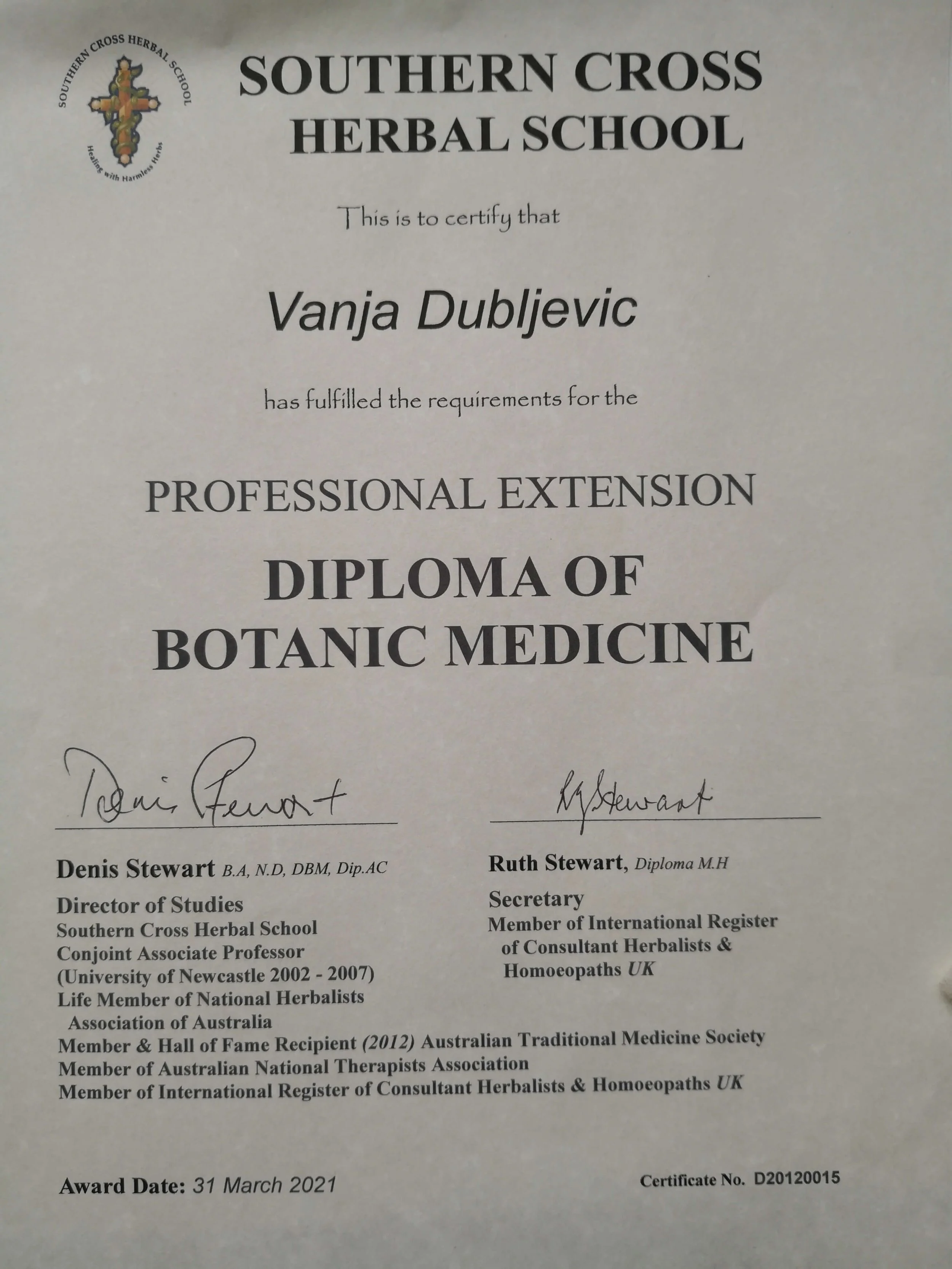My Personal Journey
In this section, I would like to tell you the story of my fertility journey. My name is Vanya, and I reside in Australia. I was 42 when I got pregnant with our vivacious daughter who is now 12 months old.
Introduction
Herbal remedies have always been a part of my early family life. I have vivid memories of my mother harvesting leaves from the pots of houseleek on our balcony in the former Yugoslavia. She would proceed to squeeze brightly colored green juice into a tablespoon and then administer it slowly into my ear canal during frequent ear infections. I still remember the soothing feeling of the cool juice in my inflamed ears. Its Latin name Sempervivum means “always living” (Alternative Healing, n.d.). English herbalist Nicholas Culpeper who catalogued hundreds of medicinal herbs in the 17th century wrote of houseleek: “If the juice be dropped into the ears, it easeth pain… It cooleth and restraineth all hot inflammations…” (Botanical.com, n.d.). Little did I know back then how vitally important herbs would become in my life, some thirty plus years later.
The Beginning
It so happened that my husband and I started planning a family in my late thirties, early forties. I took it for granted that I would be able to fall pregnant naturally. My family background was characterised by health, longevity, and fertility among female members of the previous generations, even in their late forties. I had had no major issues with my menstrual cycle, apart from suffering from dysmenorrhea (painful period), which although unpleasant was quite manageable with regular painkillers and soothing teas such as chamomile.
In my mid-thirties, I moved from Brisbane in Queensland (QLD) to Newcastle in New South Wales (NSW in Australia) and started working on the Central Coast. My work as a paediatric and complex hearing loss audiologist involved a highly dynamic working environment as well as long working hours. While I thrived professionally, my health was beginning to suffer due to the long commute of up to 3.5 hours daily and the fact that I was having limited exposure to natural sunlight. Clinical rooms had no windows. I very rarely left my desk to have a proper lunch break. In winter, I would leave home at quarter past six and arrive home shortly before seven, meaning that I would have had no exposure to sunlight during the working week.
According to Dr Eric Widra from Shady Grove Fertility in the USA, some studies have shown that adequate vitamin D may be linked to improved fertility as well as a healthy pregnancy (SGF, 2020). Sunlight enters through the iris of our eye; it stimulates the pineal gland, setting off the production of hormone melatonin (Andrews, n.d.). There is research which suggests that insufficient sunlight exposure and consequently reduced melatonin secretion can negatively impact the woman’s menstrual cycle, making it more irregular, as well as affecting ovarian function and the quality of eggs (Barron, 2007). During the two-year period of working on the Central Coast, I noticed that my menstrual cycle had shortened from anywhere between nineteen to twenty-five days. I also started experiencing night sweats which I attributed to the stress I was experiencing at work at the time.
Identifying the problem
I now realise that most of the technology nowadays is designed to try and control Nature (Weiss, 2001). The greater body of the Earth has suffered as a result, and humans have been reaping the consequences. According to The Guardian (2013), consumption of antidepressants has risen significantly since 2000. Chronic diseases such as diabetes and cardiovascular diseases have become more prevalent. More women are struggling with infertility or subfertility. From the point of view of modern medicine, we are treated as the sum of our parts, with insufficient attention being paid to the harmony of our entire being or how not just our diets but our lifestyles can adversely impact our health.
Even before I understood a possible causative effect of my stressful lifestyle on my fertility, I had become aware that it was affecting my overall health and menstrual cycle adversely. In 2018, I resigned from my position on the Central Coast and decided to travel overseas to visit my mother during summertime in Bosnia.
As I had mentioned previously, during the two-year period on the Central Coast, my periods had become somewhat erratic and ranged from anywhere between nineteen to twenty-four days, and menorrhea (bleeding) would last for four days. I discussed the issue with my mother who lived in Sarajevo, Bosnia and Herzegovina, and she suggested that I travel to a seaside town in Monte Negro called Ulcinj. There is a well-known beach known as The Ladies Beach because only women are allowed there in summertime. The sea water is rich in sulphur which comes from a subterranean spring. It is recommended to women suffering from subfertility or infertility as sulphur might improve ovum health and help regulate the menstrual cycle.
I spent eleven days in Ulcinj. I soaked myself in the sulphur rich water; I collected it for showering; I swam and took long walks, absorbing the sunshine. When I returned to Sarajevo, my mother said that I looked like a new person. There was a positive outcome concerning my menstrual cycle: It had regulated itself from twenty-four back to twenty-six to twenty-eight days. Menorrhea (bleeding) lasted for approximately five days. I felt healthy and vibrant. I was 39 at the time.
When I returned from overseas, I decided to work as a locum audiologist in regional NSW. During 2019, I travelled extensively, working in various regional clinics. Health wise, my periods and ovulation remained regular during that year, but night sweats returned although not with the same regularity nor intensity as when I was working on the Central Coast. A thorough health check-up and blood tests showed no pathology. In November 2019, I got a permanent job close to where I live in Newcastle.
My husband and I decided to start a family at the beginning of 2020. As soon as we started trying, I fell pregnant. We were both surprised and delighted that it had happened so quickly. I did a pregnancy test three days after my period was supposed to start, and it tested positive – two pink lines were clearly visible on the test screen. However, a subsequent pregnancy test showed that the second pink line had started fading. At the time, I did not know what that meant. A GP explained to me that it was most likely a miscarriage. Four to five days later my period started. Although sad, I accepted that falling pregnant might take some time. The GP also told me that many women suffered a miscarriage without even being aware of it because its timing would resemble that of their menstrual cycle.
However, from April 2020, I started noticing further changes in my reproductive cycle: I was experiencing fewer fertile days as characterized by the reduced presence of cervical mucus, and menorrhea (bleeding) would last for about three days. This was happening during the Covid 19 pandemic, when our working hours had been reduced, and I spent a lot of time walking, doing yoga, and eating healthy most of the time. Physically, I was quite fit, but I was starting to feel like a dry plant. In addition, my skin which had always been supple, felt quite dry.
In September 2020, I started experiencing more adverse symptoms: The fertile days seemed to have disappeared as no cervical mucus was being produced; menorrhea (bleeding) would last for three days maximum, with hardly any bleeding on day three; during those three days, I felt physically sick and would experience extreme fatigue, headache, nausea, brain fog, and vomiting. I could hardly recognise myself.
I booked an appointment with a GP at my local medical clinic and explained about the symptoms I had been experiencing as well as my desire to have a child. The GP asked me whether I had considered IVF. I replied that I had considered it but decided that it was not the right course of treatment for me as it seemed quite invasive, stressful, and did not offer any guarantees. She said she would like to do a general blood test to check my overall health and recommended doing a specialised blood test which determined the number of viable eggs in my ovaries. Once these results came back, we would decide what to do next. The GP was polite and professional, but I felt that I had somehow been reduced to my age (I was 41 at the time). After the appointment, I had a look at the blood test referral, and it said ‘perimenopause’. The word means “around menopause”, and it refers to the time during which the woman’s body starts transitioning towards menopause, marking the end of her reproductive years. After seeing that word, I felt quite demoralised although not hopeless. Upon returning home, I discussed the matter with my husband, and he recommended seeing a medical herbalist. This meeting marked a second chapter in my fertility story.
The Next Chapter
I booked an appointment with a medical herbalist in November 2020. When he heard about the miscarriage in March, he explained it most likely indicated insufficient progesterone to support the pregnancy. Low levels of progesterone would not be able to support the pregnancy, leading to an early miscarriage. In addition, as it seemed that I had stopped ovulating later in the year, any imbalances in oestrogen production would also need to be addressed. The treatment he would prescribe would address the hormonal imbalance overall, thus improving my chances of ovulating and having a successful pregnancy. During the appointment, he spoke of herbs which aimed to address any hormonal imbalances by having a restorative effect on the reproductive system.
I started taking the fertility mix three times a day in late November 2020 two weeks prior to my next period. What happened next, surpassed all my expectations. At the time, I was working away from home. It was an exceptionally busy week at work. Considering that in the past I would experience extreme fatigue, brain fog, nausea, vomiting, and headaches during the three days of my period, I was worried that I would not be able to work should those symptoms occur again.
When my period started, I did feel somewhat fatigued, but I had none of the other aforementioned symptoms. Furthermore, I experienced a robust menstrual flow which is how it used to be. Instead of feeling like a dry plant, I felt invigorated and restored. This wonderful experience confirmed that I was on the right track and that the fertility mix was working.
I became pregnant in late January. It came as a surprise given how much I was traveling for work at the time. During the week, I would be away and only stayed at home on the weekends. My husband and I were not expecting to get pregnant in that period, but it seems that once my reproductive system became restored, it did not need an elaborate amount of time for me to fall pregnant.
The dating ultrasound in March showed that the embryo was developing well and was advanced for its expected gestational age. I was still taking the fertility mix regularly. When the sonographer told me that the cervix was tightly closed, meaning that a miscarriage was highly unlikely, I stopped taking the fertility mix after having consulted my herbalist. Within three days, nausea, severe headache, and brain fog returned. I consulted my herbalist about this, and he recommended to continue taking the medication twice a day. Within two days, the symptoms disappeared, and I started feeling well again.
During pregnancy, the level of progesterone rises steadily. My guess was that at the time, I still needed the herbs to support my reproductive system, so that the level of progesterone could continue to rise steadily. Therefore, I am inclined to say that the fertility mix not only helped me to get pregnant but also to maintain my pregnancy.
At thirteen weeks, I had a regular ultrasound at the local hospital. It showed a healthy and well-formed foetus. It was also recommended that I do a Harmony blood test which screens for hormonal abnormalities such as Down syndrome. A week later, the results confirmed that the pregnancy was low risk and progressing well.
I have to say that during my consultations with the GP at the local health clinic and at the hospital, my pregnancy was treated as an exception to the rule, given my age (42). Being able to conceive naturally was considered almost a miracle, especially when I said that I had decided not to pursue IVF. During the consultation, the emphasis was on my "advanced" age and how high risk my pregnancy was for Down syndrome. While waiting for the results of the Harmony test, I would often talk to my mother overseas. She was born in Serbia, in the country region. Contraception was not being practiced, and it was not uncommon that women would give birth well into their late 40s. My mother did not remember any cases of Down syndrome. The lifestyle was quite simple: people ate what they grew and were active physically, often working outside, being exposed to ample sunshine and fresh air. This suggests that further research into the relationship between fertility and overall lifestyle (not just the diet) may be warranted.
The Conclusion
I am now almost thirty weeks pregnant. I stopped taking the fertility mix about two weeks ago, and prior to that, I only took it once a week since week sixteen. As the level of progesterone has continued to rise, I was able to reduce the dosage over time. My pregnancy has been going well. Apart from feeling slightly nauseous and tired at times, I had no morning sickness in my first trimester, and I have been feeling well. While I would not say that my entire experience with regards to my fertility has been an easy one, I have cherished all of it because it has led me to herbs and new knowledge which I hope will benefit other women in a similar position.
The Happy Beginning
Our daughter Nora was born on 23/10/2021 (40 weeks), weighing 3975 g and 52 cm long. She is now 12 months old and is a healthy and happy baby. Mum is somewhat sleep deprived :-).



